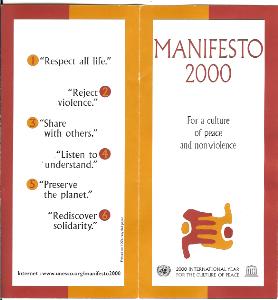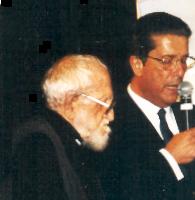Introduction and UNESCO's Mandate
Page 1
Yamousoukro and Seville Statement
Page 2
Origins and Executive Board Adoption
Pages 3 - 4
Launching the Programme: El Salvador and Roundtable
Pages 5 - 6 - 7
1993 General Conference
Page 8
National Projects
Pages 9 - 10
Programme Unit
Page 11
Toward a Global Scope
Pages 12 - 13
Transdisciplinary Project and Human Right to Peace
Pages 14 - 15 - 16
1997: A New Approach
Page 17
UN General Assembly Resolutions
Page 18
Resolution for International Year
Page 19
Declaration and Programme of Action
Pages 20 - 21
Resolution for International Decade
Pages 22 - 23
Training Programmes
Page 24
Global Movement
Pages 25 - 26
Publicity Campaign
Pages 27 - 28
Decentralized Network
Pages 29 - 30
Manifesto 2000
Page 31
Use of Internet
Pages 32 - 33
Future of the Culture of Peace
Pages 34 - 35 - 36 - 37 - 38
(continued from previous page)
In addition to the television spot and radio messages, the team of Mr Fazzino, Mr Tupper and EURO-RSCG developed a wide range of publicity materials based on the graphic logo designed in the spring of 1999 by the German artist Barbara Blickle and the Spanish graphic designer Luis Sarda de Abreu. The logo, similar to two interlaced hands, illustrated the slogan for the campaign which was originally in French "cultivons la paix" and translated into English as "peace is in our hands." The logo was the result of a long process that included a global competition which resulted in hundreds of doves, followed by a more restricted competition among professional companies in which one of the requests was "no birds, please." I argued that the dove represents the old image of peace as the absence of war, and that we needed a new, active symbol for the cultivation of a culture of peace. Among the publicity materials featuring the new logo were posters, postcards, stickers, a flag, t-shirt designs, and a very effective leaflet for the Manifesto 2000:

High points in the publicity campaign, which was built around the Manifesto 2000, were the events held at the Eiffel Tower on 4 March 1999, to announce the Manifesto, on 14 September 1999, at UNESCO and then at the Eiffel Tower, to launch the International Year for the Culture of Peace, as well as a press conference at the United Nations on 19 September 2000 for presentation of 60 million signatures. The initiative for "high places for the culture of peace" (monuments, sacred places, tourist attractions, etc.), was launched at the Eiffel Tower as foreseen in the strategy, but, with the exception of initiatives in Italy, did not achieve the global scope envisaged during the Year 2000. It is being developed further during the International Decade as the project, Heritage for a Culture of Peace The formal launch of the International Year, which took place on September 14, 1999, was marked by publicity in at least 87 countries, as documented in Annex VII. No doubt, the campaign was even greater in scope, however, as this was simply the information that we received at UNESCO headquarters.
Financing of the publicity campaign was provided by the Director-General from existing UNESCO funds, including from sector programme budgets. This was done by the Director General for a number of his priorities at that time, and it was a source of frustration to some our colleagues and to certain of the Member States. New extra-budgetary funding for the campaign was not obtained despite some efforts, including an application to the Turner Fund for $3 million that I made despite bureaucratic opposition within UNESCO.

(Click on image to see its full version)


